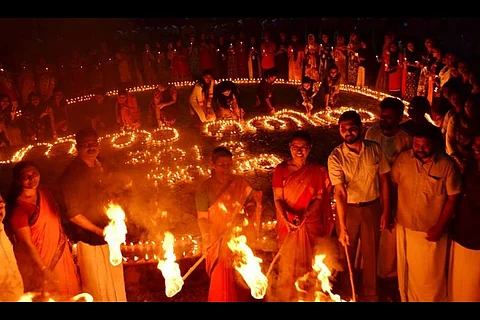

On December 2, the Kerala government had called a meeting of 190 socio-cultural and progressive Hindu organisations in light of the ongoing controversies at Sabarimala, regarding the entry of women between the age of 10 and 50. As many as 176 of them accepted the invitation and came to the CM’s chamber, with the pointed absence of a few like the NSS. When the meeting was over, Chief Minister Pinarayi Vijayan calmly spoke on a seven minute video, about the state forming a Women’s Wall on New Year’s Day, to protect the values of renaissance that Kerala is known for.
A general council was formed, SNDP general secretary Vellappally Natesan became the chairman and KPMS leader Punnala Sreekumar became general convener. “Kerala should not be made a madhouse again, is the message. We will not allow that, is the slogan,” the CM had said then, recalling Swami Vivekanandan’s past observation about the caste-based discrimination practiced in the state.
But why. Why did a quickly called upon meeting make such a huge decision.
Three months ago, when September was about to end and former Chief Justice of Supreme Court Dipak Misra was about to retire, the Constitutional bench headed by him took up the long debated case of allowing adult women to enter the Sabarimala Ayyappa Temple. The constitutional bench said yes, they could. That little yes would convert a state, just healing from the wrecks caused by an August flood, into complete mayhem.
There wasn’t time for a laymen observer to figure out what was happening. The Supreme Court said yes, women of all ages could now go to the temple, the state government said okay, we will make that happen. And the protesting voices rose, loud and clear, but mostly loud. Large groups of people, mostly right wingers, turned into protectors of tradition. Meetings were called, protest marches were conducted and angry voices labelled the women who wished to enter the temple as “activists” and “feminists”.
Police were deployed in large numbers, anticipating commotion. But so far they have been taking the women who wanted to visit the temple up to one kilometer away from the shrine, until some reason was found to escort them all the way back.
The first of the women who made attempts to enter the temple were in fact discouraged by the government because they were “activists” and this was “not the place to show their activism”. The most recent case was of 11 women coming all the way from Chennai, clearly stating it was their intention to only help the devotees among them visit the shrine. Despite their sudden change of route misleading the protestors, the police had to take them away in the end, when there were too many men on the ground to oppose their pilgrimage.
Restrictions were set in place at Sabrimala to bring a control to the protests. Arrests were made. This was greeted with hartals and indefinite fasts called by right wing leaders in front of the Secretariat.
It was in the middle of all this commotion the state seemed to be running in a loop of, that Pinarayi Vijayan called the big meeting of Hindu groups and was criticised for it soon. After the meeting he had told the media, “This is against the attempts to destroy the renaissance values and to spread awareness to people. The various communities are joining hands to make a big intervention that the country should make note of, and understand that Kerala society cannot be sent back to the old dark ages by anyone; we will not allow that.”
There was criticism from the Opposition that the Chief Minister was polarising communities. Even Leftists were critical that the government was forgetting that Communism stood for class struggles, not caste ones.
Pinarayi Vijayan answered his critics by talking about the history of renaissance in Kerala, when Communists had associated with other communities for rights of the suppressed lower castes. He then travelled from district to district talking about renaissance. In an article released by the PRD on Sunday, he wrote about the struggles the Communist Party has led in the past – like the Paliyam and Kuttamkulam agitations – with Hindu groups like the SNDP, the Pulaya Mahasabha and Pakamandalam. He also said that the Communists believe women’s liberation is part of social equality, and social inequalities are seen as part of the class struggle.
Days before the Women’s Wall is to happen, the right wingers and supporters of tradition had formed another human chain, called Ayyappa Jyothi, where thousands of women had gathered across the state. The NSS was absent there too, preferring to maintain “equal” distance from both the walls. The CM criticised their approach, calling it double standards. He asked, is there space for an equal distance when on the face of communalism, you don’t join the path of renaissance.
KPMS leader Punnala Sreekumar too reminded people of Mannathu Padmanabhan, the social reformer who marched into the Vaikom Satyagraha of 1924 conducted for the freedom of movement of the lower caste, with a ‘savarna jaada’ (march of the upper caste), to express solidarity.